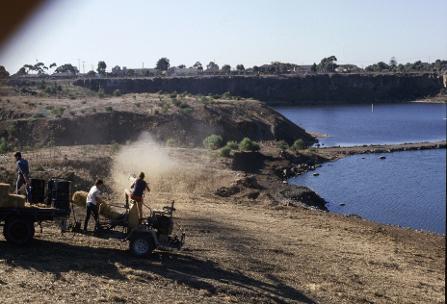1990's | ||
|
Between 1992-5, Maarten Hulzebosch planned the current reserve (he later worked with Werribee Open Range Zoo). He drained the lakes and made them shallower, about three metres. This was a safety measure. Plaque recognizing Maarten's contribution installed by FoNL
There is also a gully through the Arboretum that could bring storm water from the streets of Newport into the park. Martin's plan was that this water would filter through the lakes in the Arboretum before it reached the North and South Lakes. Currently this system is not used. To maintain a lake depth of three metres, water from an aquifer 120 metres underground is pumped into the lakes by a bore in the Amphitheatre. Unfortunately, this water is brackish and not potable . Eastern holes 1994 Seed was collected from wherever it could be found, grown and planted. This means that many of the trees in the Lakes are not indigenous but from South and Western Australia where they were locally adapted to dry conditions and sandy soils. As these trees grow we can now see they are not suited for the shallow, heavy clay soil conditions in the park. Many of these trees are breaking, their roots grow along the surface of the soil and some trees are dying. Other trees die as their roots breaks through the imported top soil into the rubbish of the old tips below. Martin built the up the land and placed the stepping stones between north and south lake. He erected the dead gums in north lake as perches for larger water birds like Cormorants. Each tree cost $500 to plant. He sculpted the 20 metre drop of the cliffs surrounding North and South Lake in order to make them safer. Between 1992 and 1995 several unemployed work schemes did more planting and weeding, built the toilet blocks, put up possum boxes in the tallest outer trees, produced a leaflet and conducted tours. The reserve officially opened on 15 December 1995 although locals have used the area unofficially for decades. In 1996, members of Department of Education, Employment and Training programs devised educational tours and leaflets and undertook re-vegetation and fencing. Earth's Backyard created a display nursery of three gardens, a greenhouse and a display of worm farms and composting. In the summer of 1997, the current Friends of Newport Lakes group formed after the disappointment of only three people (Valerie, Sarah Berry and Ron Bowman) turning up to an Earth's Backyard led meeting. In October 1996, the Hobsons Bay City Council's (HBCC) developed a Masterplan for the Newport Lakes Reserve Bushland Park. There were two versions exhibited for public comment in the following year. The other plan included a shop/tearooms and an environmental educational centre. The following is an excerpt from the bushland plan: "This plan sees the creation of a very simple bushland park. The lakes (eastern) area of the park, which is already open for visitors, will continue to be a bushland haven. |
Planting will be extended into the western half of the park. New picnic areas will be created on the sites which were formerly the tip holes and have now been "capped" with clay." Implementation of this simple design could begin within a short period of time. The bushland park could then be added some of the types of activities outlined in the "Future Park Development Options" plan. Improvements to the park will include planting native trees and shrubs in and around North West Hole, Paveys Hole and the western part of the park. The native planting will encourage birds and wildlife into the park, allowing visitors to enjoy the sounds and sights of the bush. The arboretum area will be refined, with trees grouped into their country of origin, use or botanical features. A bicycle and walking track will be built through the park, with entrances off Margaret Street, Johnstone Street, Percy Street and Bruce Street. Walkers will also be able to enjoy strolling along a number of smaller walking tracks. Car access to the park will be restricted, with the only car entry off Margaret Street and with pedestrian entry off Bruce Street, Margaret Street and Johnstone Street. Picnic areas have been built around the lakes area, providing a peaceful setting for family gatherings. Additional picnic areas will be built at Pavey's Hole and NW Hole. To protect wildlife, dogs will not be permitted in the eastern (lakes) section. Dog walkers will be free to walk their dogs on leads in the western section. In the future, we hope to get support through a local friends group and through local businesses and institutions."
Hydroseeding - 1989 In 1997-8, the nursery closed and Earth's Backyard left Newport Lakes. The Friends start holding 7-10 public events a year planting, weeding and educating members. Newport Lakes starts to become a regular venue for 'Blue Heelers', filming adverts, nude photography, weddings and funerals. In 1998, HBCC released plans for BBQ shelters. The Friends ran a recycled watering project with Shell and Ecogen and built and installed bird boxes. The fence surrounding the Arboretum is finally removed. In 1999, BBQ shelters were using poles donated, through the Friends, by AGL. Benches are built in the Arboretum. HBCC released plans for a playground to be built in the BBQ shelter area. This was not subsequently built. Some of the funds were used to improve the drainage of the area. The Friends ran a photo competition and set up its web site. In 1999, HBCC released its first five-year Vegetation Management Plan. This expires in 2003. The plan splits the park into several similar zones. It describes what trees/plants are to be planted, where and when and what weeds are common where and when and how they should be destroyed. HBCC start to hold major plantings with schools and corporate sponsors (such as Toyota). FoNL received a $3500 community grant to create a bird hide, a mosaic bird trail and trail leaflet. | |
